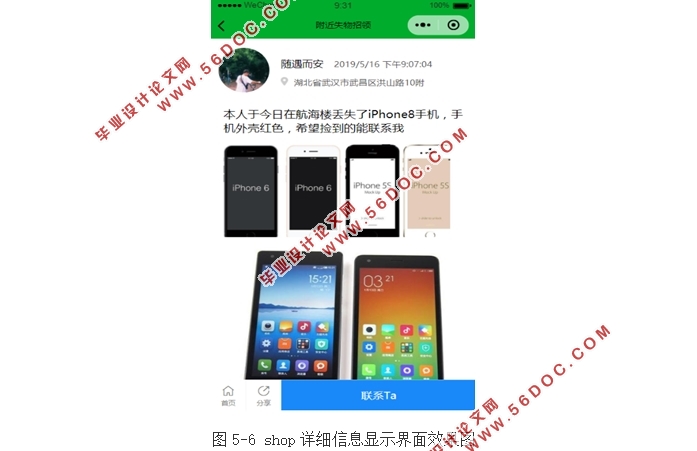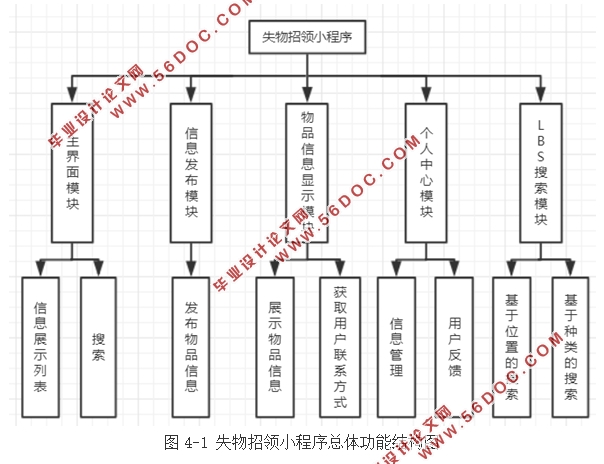基于LBS的搜索服务微信程序(失物招领平台)设计
来源:56doc.com 资料编号:5D20941 资料等级:★★★★★ %E8%B5%84%E6%96%99%E7%BC%96%E5%8F%B7%EF%BC%9A5D20941
资料以网页介绍的为准,下载后不会有水印.资料仅供学习参考之用. 密 保 惠 帮助
资料介绍
基于LBS的搜索服务微信程序(失物招领平台)设计(任务书,开题报告,论文14500字,参考代码)
摘 要
随着我国经济的不断发展,人们的生活节奏不断加快,活动范围也在不断扩大,我们身边每天都发生着丢失物品或者是捡到失误的情况,失主着急找自己丢失的东西如同大海捞针,捡到失物的有心人想归还失物却无从找起,而现如今存在的失物招领平台或多多少都存在一些问题。为了解决这种现实需求,本文设计并实现了基于微信平台的失物招领服务的小程序,该小程序依托了现在人人都在使用的微信平台,并且使用了当下常用的LBS服务,为用户提供了一个基于位置的发布失物和招领信息的平台。同时,用户可以根据物品遗失或者被捡到的位置,方便其他用户进行搜索,使其他用户能够很快的找到物品的信息。本文详细的阐述了基于LBS搜索服务的微信程序的开发过程中的主要内容和过程,包括系统的需求分析,设计过程及开发实现过程。
关键词:微信;失物招领;服务;位置;小程序
Abstract
With the continuous development of China's economy, people's life rhythm is constantly accelerating, and the scope of activities is constantly expanding. Every day around us, there are lost items or mistakes. The owner is anxious to find what he has lost as a needle in a haystack. Lost people who want to return lost things can't find them, but there are some problems with the lost and found platforms that exist today. In order to solve this kind of practical demand, this paper designs and implements a small program based on WeChat platform for lost and found services. This small program relies on the WeChat platform that everyone is using now, and uses the commonly used LBS service to provide users with A location-based platform for publishing lost and captured information. At the same time, the user can facilitate other users to search according to the location where the item is lost or picked up, so that other users can quickly find the information of the item. This paper elaborates on the main content and process of the development process of WeChat program based on LBS search service, including system requirements analysis, design process and development implementation process.
Key Words:WeChat;Lost and found;service;location;applets


目录
摘 要 I
Abstract II
第1章 绪论 1
1.1 项目背景 1
1.2 课题相关国内外发展现状研究 2
1.3 课题的主要内容和论文的组织结构 3
第2章 失物招领微信小程序的相关技术综述 4
2.1 微信小程序简介 4
2.2 微信小程序云开发简介 5
2.3LBS服务简介 6
2.4 本章小结 6
第3章 失物招领微信小程序的需求分析 7
3.1 需求分析综述 7
3.1.1 客户端特点分析 7
3.1.2 用户特征分析 7
3.2 功能性需求分析 8
3.2.1 主界面模块 8
3.2.2 信息发布模块 8
3.2.3 物品详细信息显示模块 8
3.2.4 个人中心模块 9
3.2.5 LBS搜索模块 9
3.3 非功能性需求分析 9
3.4 本章小结 9
第4章 失物招领微信小程序概要设计 10
4.1 设计目标 10
4.2 小程序端总体功能结构 10
4.3 数据库设计 11
4.4 本章小结 13
第5章 失物招领微信小程序详细设计与实现 14
5.1 主界面模块 14
5.1.1 主界面模块流程分析 14
5.1.2 主界面模块类设计 14
5.1.3 主界面模块效果展示 15
5.2 信息发布模块 16
5.2.1 信息发布模块流程分析 16
5.2.2 信息发布模块部分类设计 17
5.2.3 信息发布模块效果展示 18
5.3物品详细信息显示模块 19
5.3.1 物品详细信息显示模块流程分析 19
5.3.2 物品详细信息显示模块部分类设计 20
5.3.3 物品详细信息显示模块效果展示 21
5.4 个人中心模块 22
5.4.1 个人中心模块流程分析 22
5.4.2 个人中心模块部分类设计 23
5.4.3 个人中心模块效果展示 23
5.5 LBS搜索模块 24
5.5.1 LBS搜索模块流程分析 24
5.5.2 LBS搜索模块部分类设计 25
5.5.3 LBS搜索模块效果展示 26
5.6系统测试 27
5.6.1 测试环境 27
5.6.2 测试方法 27
5.6.3测试用例设计 27
5.7本章小结 29
第6章 结论 30
6.1 全文总结 30
6.2 参考文献 30
致 谢 32
|





